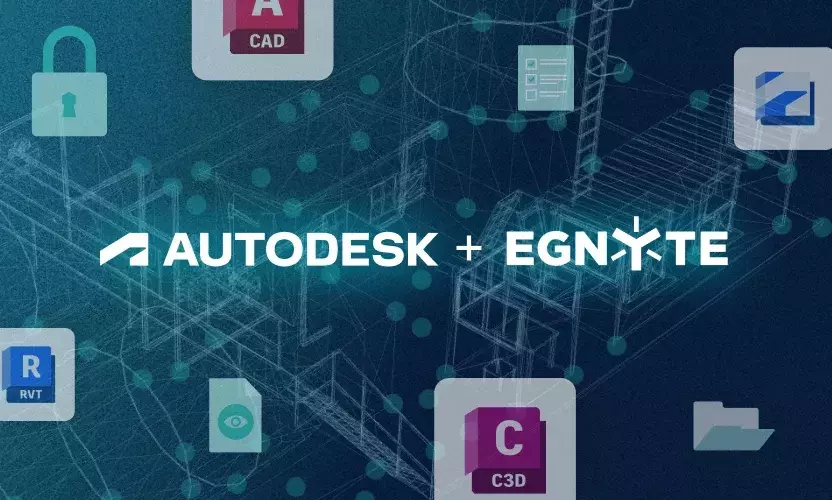
Transitioning From Silos to Synergy: How Integrations and Data-Driven Decision-Making Will Transform AEC
In the ever-evolving Architecture, Engineering, and Construction (AEC) world, the dance between technology and data management is reshaping the industry. A pivotal aspect of this transformation lies in seamlessly integrating AEC tools like AutoCAD, Revit, Procore, and more with robust data management systems. This blog post delves into the critical significance of these integrations, illuminating how they enhance productivity, encourage data-driven decision-making, and mitigate risks.
The Surge in Data Storage and Data Set Sophistication
As AEC projects grow in complexity, so does the magnitude of the data generated. Recent trends indicate a significant increase in data storage requirements, coupled with a surge in the size of the data sets used by AEC professionals. This paradigm shift signals a growing sophistication in the industry's ability to leverage data sets effectively. The traditional belief that larger files hinder productivity is giving way to a new realization — when effectively managed, large data sets open up new avenues for innovation and collaboration.
The Evolving Role of AEC Tools
AEC professionals heavily rely on a suite of specialized tools to bring their projects to life. AutoCAD, Revit, Procore, and others have become indispensable companions in the daily workflows of architects, engineers, and construction teams. Yet, the true power of these tools is realized when they seamlessly integrate with data management systems.
Boost Productivity through Integration
In the swiftly evolving AEC landscape of today, the rise in size and intricacy of architecture and engineering projects poses a distinctive challenge. Managing the massive amount of data generated in the Building Information Modeling (BIM) authoring process can become overwhelming. The solution lies in seamlessly integrating AEC tools with robust data management solutions, creating an ecosystem where efficiency thrives.
As projects grow in scale, so does the need for a modern, flexible, and efficient file management infrastructure. Traditional on-premises file servers struggle to keep pace with the dynamic demands of contemporary AEC workflows. Enter Egnyte’s cloud-first solution enabling teams to access and work on project files from anywhere on any device while ensuring that project data is kept up-to-date across all platforms.
Consider a scenario where architects and engineers collaborate on intricate design iterations within the BIM framework. The complexity of these projects necessitates a cloud platform that seamlessly integrates with popular AEC tools such as AutoCAD, Revit, Autodesk Construction Cloud, and Newforma. Moreover, integration extends beyond that; it reaches the core of productivity by ensuring compatibility with indispensable productivity applications such as Microsoft Office 365, Teams, and Zoom.
An interconnected ecosystem is not just a technological upgrade; it's a strategic move to address the evolving needs of modern AEC workflows. Integrating cloud-based solutions with industry-standard tools ensures that professionals can access, share, and collaborate on project data effortlessly.
Empowering Data-Driven Decision-Making
In the dynamic realm of AEC, integrating AEC tools with advanced data management systems heralds a transformative era of data-driven decision-making. In an industry where every decision can impact the success of a project, having real-time access to accurate information is paramount. These integrations serve as a catalyst, seamlessly connecting professionals with the wealth of project data, and empowering them to make informed choices.
Consider the scenario construction firms face, a segment where synchronization between construction management software like Procore and project folders is often a significant challenge. The traditional solution involves assigning a dedicated resource to manually ensure all stakeholders are working with the correct project information. Yet, this manual intervention proves to be a slow process and introduces a potential bottleneck. Should the dedicated resource stumble or delay tasks, project teams may find themselves operating with outdated or inaccurate data, resulting in rework and wasted project time.
Enter the solution: a document management platform that transcends traditional approaches. It eliminates the need for a middleman by establishing a seamless, two-way sync between systems. This signifies that project documents are accessible in Procore and the integrated cloud platform, ensuring uniform access to the same files, regardless of the user's location. Critical tasks such as renaming, moving, and delta running are updated hourly, creating a dynamic environment where project stakeholders can trust that they are always working with the most accurate and up-to-date information.
Mitigating Risks through Collaboration
One of the most significant advantages of AEC tool integrations is the enhanced collaboration they facilitate. Construction projects involve many stakeholders—architects, engineers, general contractors, specialty contractors, and more. Effective collaboration is contingent on the ability to share and synchronize data seamlessly.
Integrated tools ensure that all team members work with a unified dataset, reducing the risk of errors and miscommunication. Updates made within one tool immediately resonate throughout the entire ecosystem, cultivating a collaborative environment where all stakeholders are aligned.
The Road Ahead: Toward a Unified AEC Ecosystem
The trajectory of AEC is undeniably pointing towards a more unified and interconnected ecosystem. Integrating tools and data management systems is not just a technological enhancement; it's a strategic imperative for staying competitive in a dynamic industry.
As we navigate the future of AEC, the importance of integrations will only intensify. AEC professionals embracing this shift are not merely adapting to change—they are pioneering a new era where technology and data converge to redefine what's possible in architecture, engineering, and construction.




